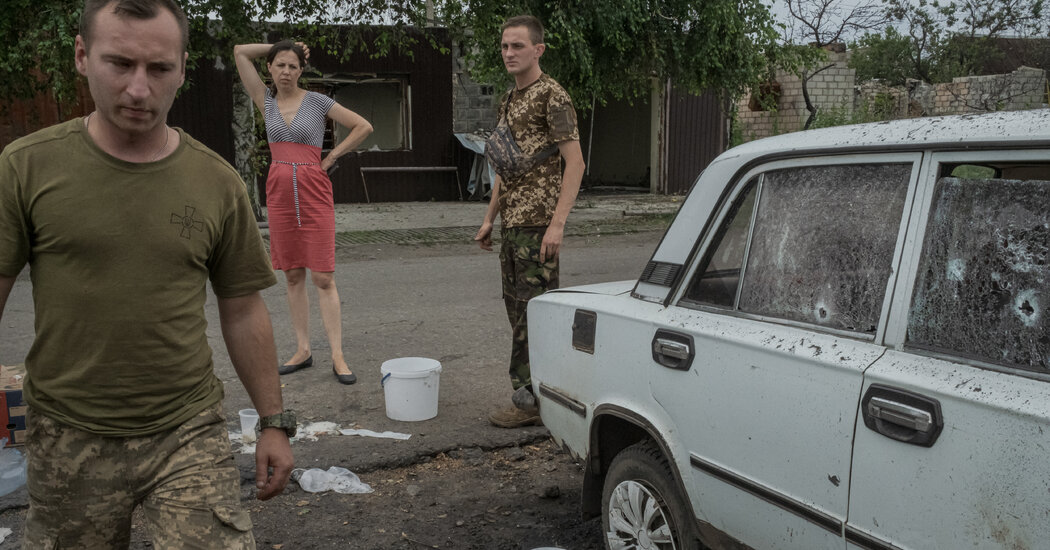Nuclear Disaster Averted After Ukraine Dam Break. But What Threats Remain?
This week, the head of the United Nations atomic watchdog, Rafael Mariano Grossi, was so concerned about a new risk at the Zaporizhzhia Nuclear Power Plant that he flew to Ukraine and crossed the front line in the country’s war with Russia to see the situation for himself.
Mr. Grossi had been to the plant before and had also expressed grave concerns about the potential for nuclear catastrophe, but this threat was different: The recent destruction of a dam on the Dnipro River had deprived the plant of the main source of water used for the critical task of cooling its six reactors and spent fuel rods.
But on Friday, after his visit to the plant, Mr. Grossi presented some good news, saying that the existing stored water at the plant would support the reactors for a “few months” and that the authorities there had started to take other steps to replenish the supply.
Here is what to know Ukraine’s nuclear industry and why the Zaporizhzhia plant is under threat:
Why does the Zaporizhzhia plant matter?
Few countries are as reliant on nuclear power for their energy supply as Ukraine. Before Moscow launched its full-scale invasion in February 2022, the nuclear industry supplied around half of Ukraine’s energy needs.
Ukraine has 15 reactors at four plants. Three facilities are far from the war’s front lines. The fourth, the Zaporizhzhia plant, was occupied by Russian forces in a blaze of gunfire in March last year. It no longer produces power for Ukraine’s grid, but because it is an active nuclear plant, its safe operation remains imperative to prevent a disastrous meltdown.
The country’s industry has a troubled history. The first reactor came online during the Soviet era, and in 1986 an explosion and fire at the Chernobyl plant in northern Ukraine set off the worst nuclear accident in history.
Why is water so important for the plant?
Water cools both the reactor cores and the spent nuclear fuel, and as a result, the plant relies on a large and constant supply.
To answer the need, it is built near a reservoir that is up to 14 miles wide on the Dnipro River. That body of water feeds a giant on-site cooling pond — larger than the National Mall in Washington — and water from the pool is, in turn, pumped to the plant’s six reactors.
The design minimizes the risk that the reactors could ever run short of the water needed to prevent a meltdown.
What is the latest risk, and what is being done?
The level in the reservoir that serves as the nuclear plant’s primary water source has fallen drastically since June 6, when an explosion destroyed the Kakhovka dam, flooding the lower river basin and killing at least 14 people.
There is no immediate danger at the plant, however, because the cooling pond is full and the reactors require much less water than they normally would have.
Because of the war’s threats to the plant, five of the reactors have been in “cold shutdown” mode since last year, an idle state in which they do not produce power. The sixth is in “hot shutdown mode,” which means it produces some power for safety at the plant.
Mr. Grossi said on Friday that he was encouraged that backup steps were being taken to help supplement the existing water in the pond, which is evaporating. He said that without that, “there will be a very serious problem very clearly before the end of the year.”
It will be years before the dam and reservoir are restored, Mr. Grossi said, so plant workers have started installing pumps to bring water from the depleted reservoir, whose banks are retreating to the original riverbed. They are also making plans to drill deeper into the ground to the water table to create wells that could feed the pond, he added.
What’s the broader problem?
It’s the obvious one. The Zaporizhzhia plant is in a war zone, the first time in history that a nuclear plant has been occupied by a foreign power.
The Ukrainian authorities say that Russian forces have laid mines on the plant’s grounds to prevent an attack, stored weapons and explosives in its rooms, set up gun emplacements and billeted troops there en route to the battlefield.
Moscow has also tried to impose management control, with on-site Russian managers putting pressure on workers to break their contracts with Ukraine’s state nuclear company, Energoatom, and to sign on with Russia’s nuclear company, Rosatom. They have also pressed them to apply for Russian passports, according to Oleh Korikov, Ukraine’s inspector for nuclear and radiation safety.
In the process, workers say that some people have been detained and tortured and the staff of 11,000 has been cut to a skeletal crew of around 2,000, Mr. Korikov said. Many of the remaining workers are not allowed to go to the plant, because they refuse to sign contracts with its Russian controllers, Mr. Grossi said on Tuesday.
Long-term nuclear safety requires adherence to principles enumerated by the United Nations watchdog, the International Atomic Energy Agency, including a stable political environment, a predictable management structure and a calm environment for workers and full staffing. These principles have been violated at Zaporizhzhia, according to Mr. Grossi.
What about actual fighting?
Ukraine has made no attempt to retake the plant. Last summer, however, shelling damaged an area where spent fuel is stored, the most serious of a series of shelling incidents.
In addition, the plant has been forced to rely on diesel generators on seven occasions as electricity lines that bring power to the plant have been severed by shelling.
A constant supply of electricity is crucial for turning the pumps that circulate the cooling water. Each time, the power lines have been quickly reconnected, but the incidents raised concerns because the diesel fuel stored at the plant, to be used in backup generators, would last only for days.
More broadly, the facility is near a front line at a time when Ukraine has kicked off a counteroffensive to reclaim territory in the south and east of the country. The plant, which sits on the east bank of the river, is part of a belt of land north of the Sea of Azov that is held by Russian forces. Any fighting in the vicinity would be an additional risk, according to Mr. Grossi.
In the longer term, the I.A.E.A. proposed last year that the plant should be demilitarized with a deal by both sides not to attack. The governments in Kyiv and Moscow have, however, not agreed to establish a security zone around the plant.
One obstacle, according to experts, was Ukraine’s unwillingness to formally recognize Russian control of a plant on its soil. For its part, Moscow, which illegally annexed the Zaporizhzhia region last October and now considers the nuclear plant part of Russia, was unwilling to relinquish its control.
William J. Broad contributed reporting.


